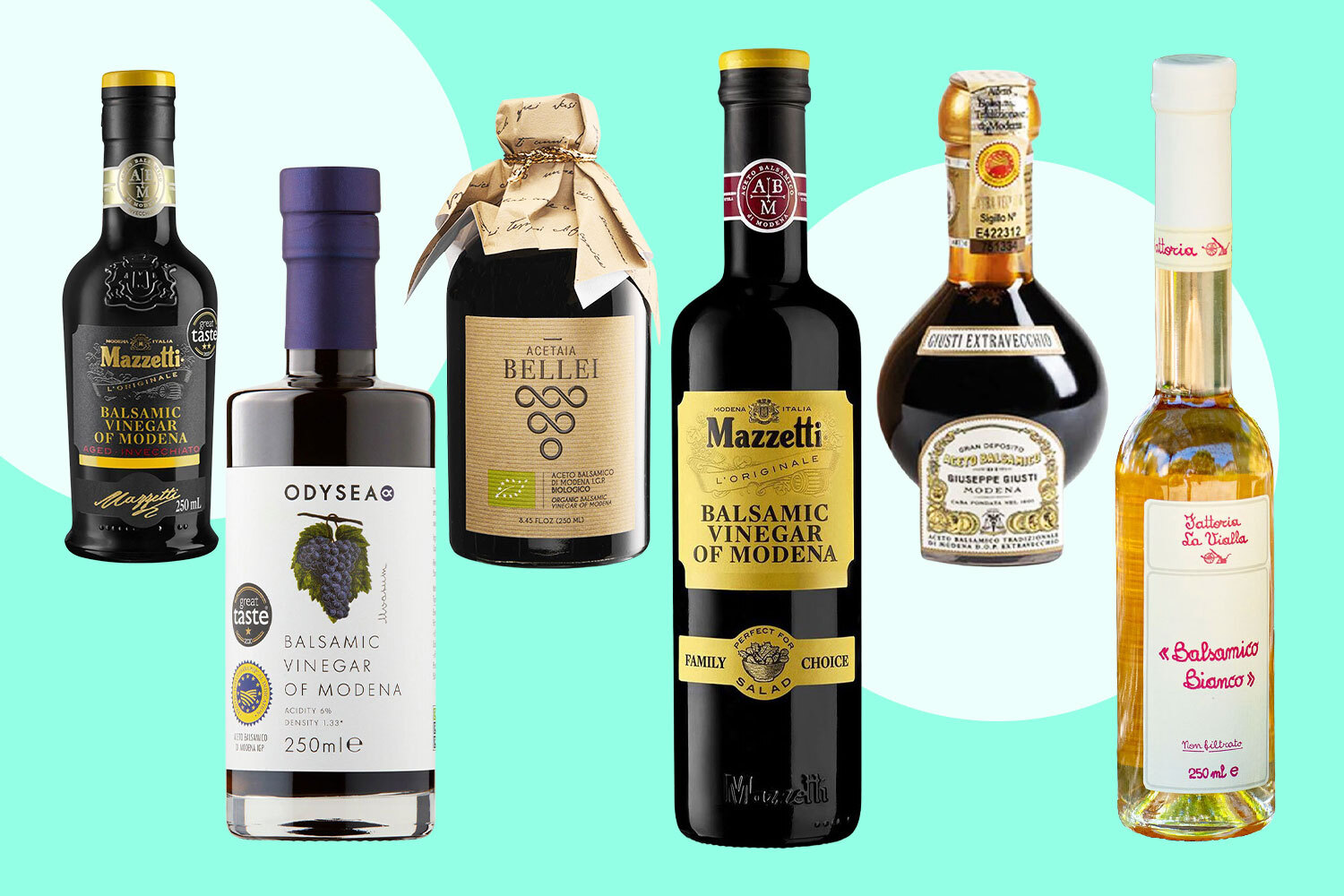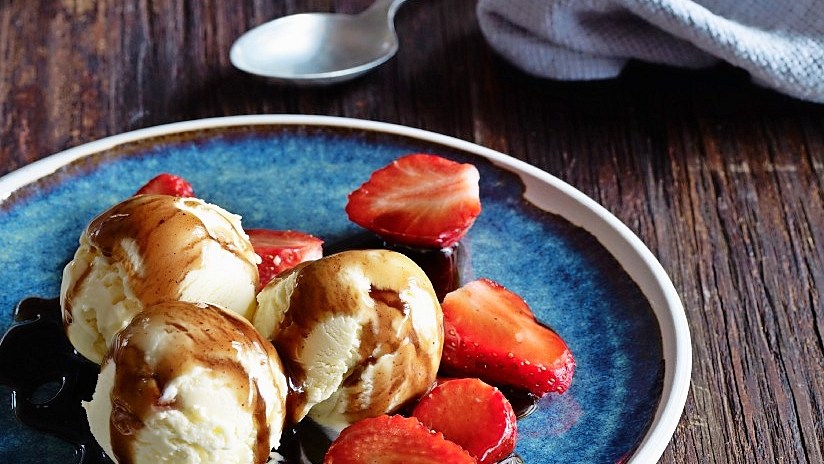Everyone’s heard of balsamic vinegar. In fact, our supermarket shelves are lined with bottles and bottles of the glossy black liquid. But did you know that there are actuallytwo types of everyone’s favourite sweet and sour condiment and that one is ever so exclusive?
The original product, which gave birth to the one we’re familiar with in the UK, follows a centuries-old method and requires a lot of patience — 12 years, in fact, and 25 if you want your vinegar to be classed as extra vecchio (extra aged).
It is so uniquely delicious that it’s known as the “black gold of Modena”, but its official title is Aceto Balsamico Tradizionale di Modena DOP.
It’ll cost you about £100 per 100ml and is harder to get your hands on than good truffles. There are only about 260 certified producers and with such a long production process not much is made a year — in 2023, 14,500 litres, or 142,000 100ml bottles, were produced. No wonder it’s so hard to come by in the UK. There are only a few stockists in London and a handful of chefs using it in their restaurants. However, those in the know are hooked.
“It’s very expensive but you only need a few drops of it,” says the chef Theo Randall, who cooks Italian food at the InterContinental in London. “The length and depth of flavour is far superior to regular balsamic vinegar. It’s like a really fine wine.”
On trying it for the first time during a trip to Modena at the end of last year, I was shocked at just how special it is. It is intensely complex, thick and palate-coating, and perfectly balanced between sweet and sour without any of the harshness that can come with regular balsamic vinegar.
It’s delicious enough to eat neat from a spoon; in fact, it’s better that way. Without other competing flavours, your tastebuds can enjoy the mind-bending number of different notes in the “black gold”. They can include wood, chocolate, cinnamon, vanilla, figs, prunes, raisins, cherry, caramel, molasses, toasted almonds and walnuts — a symphony of different flavours.

Francesco Mazzei
THOMAS ALEXANDER
“It’s a true gastronomic treasure,” says the Italian chef Francesco Mazzei, who plans to use the ingredient at his Italian restaurant opening at the Corinthia London hotel in October. “It’s a different league, a different level. Anyone who’s interested in food needs to try this.”
The incredible flavour is achieved with just one ingredient and more than a decade in time. “Caviar requires about six months to a year, truffle comes every year, but for a DOP balsamic vinegar you need between 12 and 25 years, so that’s why it’s so exclusive and one of the top ingredients in the world,” Mazzei says.
• Fior di latte: will you be eating it this summer?
The DOP status, or PDO (protected designation of origin) in English, means it can only be made in the Modena region using specific grapes grown there — mainly trebbiano. There is also Aceto Balsamico Tradizionale di Reggio Emilia, protected by a separate DOP.
Makers must follow a specific recognised method and the final product must meet exacting standards. First, grape must (freshly pressed juice containing the skins and stems of the fruit) is cooked down until syrupy before being placed in a set of consecutively shrinking wooden barrels to age.
Each barrel is made from a different wood (oak, chestnut, cherry, juniper, mulberry, ash) and each imparts a unique flavour. As it evaporates and concentrates, the must is moved along from the biggest barrel to the smallest, with the first being topped up with new cooked grape must. Eventually every barrel is topped up by the one that precedes it.
True Aceto Balsamico Tradizionale di Modena DOPcan only be sold in the specific spherical-bottomed, rectangular-based 100ml bottles created by the designer Giorgetto Giugiaro and must carry the red-yellow PDO label.
“It’s a totally different product,” says the restaurateur James Chiavarini, who ages his own balsamic vinegar in his Kensington restaurant La Palombe, as well as importing it from Italy. “When we give it to people in the restaurant they just think it’s outstanding.”
Enrico Corsini, the president of the Traditional Balsamic Vinegar of Modena Consortium, says that in recent years there’s been a growing interest in the product. “Thanks to continuous education and promotion globally, the number of people who recognise and appreciate the superior quality of our vinegar is constantly increasing.”
So what supermarket balsamic have we been consuming? That’s the PGI (or IGP in Italian). Confused? Let me explain.
Aceto Balsamico di Modena IGP is made by blending cooked grape must and red wine vinegar. It can vary in taste and consistency depending on the balance of ingredients and how long it’s been aged. “If there’s more red wine vinegar, then it’s more fluid and has a sharper consistency, but if there’s more grape must and the product is aged, then it becomes thicker, richer and more rounded in taste with a natural sweetness balancing its acidity,” Mazzei says.
“Both the IGP and the DOP are good in their own right and have different uses, but the most important thing is to look out for those logos — there are lots of imitations so it’s absolutely crucial to be 100 per cent sure you’re buying authentic Aceto Balsamico di Modena.”
Now that we know the world of balsamico is far more complicated than we thought, how best to put this knowledge to use? Here’s how to use balsamic like a pro …
Make a two-ingredient dessert that will wow everyone
If you invest in a bottle of tradizionale, one brilliantly decadent way to enjoy it is drizzled on good vanilla ice cream. “It’s so delicious,” Chiavarini says. “It’s thick and syrupy and goes perfectly with the mellow, cold creaminess of the ice cream. But beware, this does not work with a cheap, regular balsamic you might pick up in a convenience store. You need the expensive stuff here.”
It is also good dotted on top of fresh strawberries, peaches or melon for a simple yet elegant dessert.
Don’t cook with tradizionale
It shouldn’t be cooked or emulsified because the heat will destroy its flavour. Instead, use the good stuff as a garnish, Mazzei says. “It’s brilliant on top of fresh homemade pasta, really wonderful on steak and goes great with a range of vegetable dishes.”

At his restaurant, Theo Randall reserves the DOP for dishes such as prosciutto di parma with gnocco fritto because it perfectly offsets the richness of such food.
“I think one of the most delicious ways to enjoy it is drizzled on chunks of parmigiano reggiano or pecorino — a stylish, delicious and memorable appetiser,” Randall says.
The best balsamic for salad
A good Aceto Balsamico di Modena IGP is perfect for a salad and you can play around with different ones for different effects. Its flavour profile ranges from tangy and fresh to rich and velvety, according to the Balsamic Vinegar of Modena Consortium (there is also a consortium for the traditional type).
Mazzei says, “With its freshness and fine acidity, the IGP is great for everyday salads. If I were making a more sophisticated salad, I might use an aged IGP or possibly a DOP but only in very small amounts.”
The DOP often comes with a small dropper dispenser to ensure that you don’t accidentally flood your dish with wasteful amounts of the precious liquid.
What about white balsamic?
Although it’s not technically a true balsamic, white balsamic is very tasty. It’s still made using grape must, but it isn’t cooked for as long, which prevents it from developing a dark colour. There is also minimal or no ageing. “The aromas are refined and recall dried fruit, vin santo and white almond blossom,” says Antonio Lo Franco, who co-owns Fattoria La Vialla, an organic farm that sells balsamico bianco online.

White balsamic can sharpen up a risotto
RUA CASTILHO/STOCKFOOD
“It’s suave and fragrant and has delicate acidity, which is excellent on seasonal vegetables — steamed or roasted — in fish risotto or, mixed with a little oil and salt, as a dressing on a mixed leaf salad.”
It’s also Theo Randall’s go-to for a salad, he says.
Where to buy the good stuff (and how to avoid the bad)
Most supermarkets stock IGP balsamic, but for the DOP you have to search a little harder. Some delis, such as Panzer’s Delicatessen in north London, will stock it and if you want to buy it online you can head to Sous Chef.
Always look out for the IGP and DOP phrasing and logos and check the ingredients. The IGP should only contain grape must and wine vinegar and the DOP should only contain grape must. Another telltale sign of a fake is the use of misleading numbers on the labels to indicate the ageing time.
What on earth is balsamic glaze?
Balsamic glaze — that thick, gloopy, very sweet condiment you find in bad Italian restaurants in the UK — has very little to do with real balsamic vinegar. It’s normally made with a little vinegar, some cooked grape must and thickeners such as xanthan gum and modified corn starch. In my opinion, it’s best left on the shelf.
 The best balsamic vinegarsBellei Balsamic Vinegar of Modena IGP
The best balsamic vinegarsBellei Balsamic Vinegar of Modena IGP
Best for cooking
This is a good quality organic IGP with a lovely velvety texture that is perfect on steamed vegetables or fish or added to sauces to enhance them. Sometimes I add a dash to my bolognese. £17.50 for 250ml; ocado.com
Odysea Balsamic Vinegar Of Modena IGP
Best for dipping
One of the greatest snacks is good quality bread dipped in extra virgin olive oil and balsamic vinegar. This IGP by Odysea is ideal for that. It’s smooth, well balanced and not at all watery, which means it doesn’t swim about on the plate. Get dipping, folks. £11.15 for 250ml; Sainsbury’s
Mazzetti Balsamic Vinegar of Modena IPG
Best value
This light, tangy balsamic vinegar has a higher ratio of red wine vinegar to grape must, which makes it zingy, zesty and punchy. It’s a great price and the thinner consistency means it is lovely on salads, splashed on grilled meat and mixed into marinades. £5 for 500ml; ocado.com
Fattoria La Vialla Balsamico Bianco
Best white balsamic
This is the best white balsamic. It’s fruity, sweet, tart and tangy, and makes every salad delicious. My favourite salad dressing is a mix of balsamico bianco, extra virgin olive oil, sea salt and a little fresh lime juice. Addictively good. Box with 4 x 250ml bottles, £24.80; lavialla.com
Mazzetti Aged Balsamic Vinegar Black Label
Best posh dupe
If you don’t want to splash out on the expensive stuff but would like a balsamic vinegar that’s sweet, thick and rich, this is the one you should buy. It’s an IGP that’s been aged in oak barrels so that it becomes dense and sweet with cooked fruit and aged wood notes. It doesn’t taste quite as complex as a tradizionale, but no one could argue it’s not tasty. It’s perfect drizzled on cheese or ice cream. £15 for 250ml; ocado.com
Giusti Balsamic Vinegar of Modena DOP Extravecchio
Blow the budget
Obviously, dropping nearly £150 on 100ml of liquid seems like a crazy thing to do but, trust me, once you’ve tried this, your life will never be the same again. It is the crème de la crème of the vinegar world and is unlike any vinegar you’ve tasted. It’s silky and smooth without being sticky or cloying and is delightfully complex in flavour, with sweet and sour notes in perfect harmony. It’s woody, warm and aromatic with a lingering flavour of caramel that makes you want to go back for more. It’s perfect on strawberries, parmigiano reggiano and homemade focaccia or just eaten on its own from a spoon. £139.99 for 100ml; souschef.co.uk

